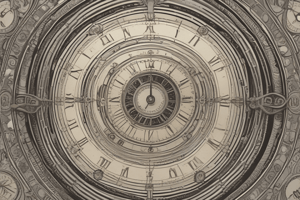Podcast
Questions and Answers
The phrase 'I am running early' implies that a person is behind schedule.
The phrase 'I am running early' implies that a person is behind schedule.
False (B)
When someone says 'I'm on time for my appointment,' it means they are punctual.
When someone says 'I'm on time for my appointment,' it means they are punctual.
True (A)
'What time is it?' is a phrase used to ask for the current time.
'What time is it?' is a phrase used to ask for the current time.
True (A)
'I am late' expresses a situation where the person is ahead of schedule.
'I am late' expresses a situation where the person is ahead of schedule.
The phrase 'It's 4:30 p.m. now' is used to state the future time.
The phrase 'It's 4:30 p.m. now' is used to state the future time.
What does a time of 12:00 AM represent?
What does a time of 12:00 AM represent?
If someone says 'I have to leave at 6:30 PM,' what time are they referring to?
If someone says 'I have to leave at 6:30 PM,' what time are they referring to?
Which phrase is commonly used to inquire about the current time?
Which phrase is commonly used to inquire about the current time?
When does the phrase 'I am running early' typically apply?
When does the phrase 'I am running early' typically apply?
Which time phrase is used to express punctuality?
Which time phrase is used to express punctuality?
Flashcards are hidden until you start studying
Study Notes
Telling Time in English: Hours, Minutes, AM/PM, and Telling Time Phrases
Telling time in English is essential for non-native English speakers and those learning the language. Familiarity with the concepts of hours, minutes, AM/PM, and telling time phrases is crucial for understanding and using time-related expressions in various contexts.
Hours
Hours are units of measuring time, with 24 hours making up a day. The 12-hour clock system is commonly used to express hours, with a.m. (ante meridiem, before noon) and p.m. (post meridiem, after noon) indicating morning and afternoon respectively.
For example:
- 2:30 p.m. is two hours and thirty minutes after noon.
- 11:45 a.m. is eleven hours and forty-five minutes before noon.
Minutes
Minutes are used to express fractions of an hour. There are 60 minutes in an hour, so 30 minutes past the hour is half an hour, and 15 minutes past the hour is a quarter of an hour.
For example:
- 3:30 p.m. is three hours and thirty minutes after noon.
- 2:15 p.m. is two hours, fifteen minutes past the hour.
AM/PM
The AM/PM system divides the day into twelve segments, with a.m. denoting the morning hours (12 a.m. to 11:59 a.m.) and p.m. denoting the afternoon hours (12 p.m. to 11:59 p.m.). The time is reset to 12 a.m. at midnight, and the next day starts at 12 p.m.
For example:
- 7:00 a.m. is seven hours after midnight.
- 9:30 p.m. is nine hours and thirty minutes after noon.
Telling Time Phrases
Understanding time-related phrases is essential for accurately expressing and understanding time. Some common phrases include:
- It's (a certain time) now: This phrase is used to state the current time, such as "It's 4:30 p.m. now."
- What time is it? This phrase is used to ask for the current time, such as "What time is it?" or "What's the time?"
- I am late: This phrase is used to express a situation where a person is running late, such as "I'm late for my appointment."
- I am early: This phrase is used to express a situation where a person is ahead of schedule, such as "I'm early for my appointment."
- I am on time: This phrase is used to express a situation where a person is punctual, such as "I'm on time for my appointment."
- I am running late: This phrase is used to express a situation where a person is behind schedule, such as "I'm running late for my appointment."
- I am running early: This phrase is used to express a situation where a person is ahead of schedule, such as "I'm running early for my appointment."
In conclusion, understanding the concepts of hours, minutes, AM/PM, and telling time phrases is essential for accurately expressing and understanding time in English. By familiarizing yourself with these concepts, you can effectively communicate time-related information in various contexts.
Studying That Suits You
Use AI to generate personalized quizzes and flashcards to suit your learning preferences.




